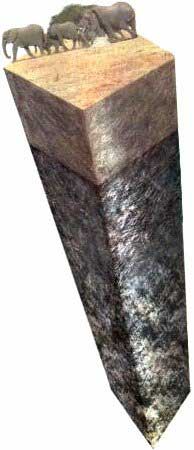|
|
|
Savanna is a biome
of the tropical. It is located in
extensive regions of Africa, Asia,
Australia and South America. In it
the herbaceous vegetation predominates.
Nevertheless, it does not lack trees,
although these are dispersed.
The ground of the
savanna is argillaceous and waterproof.
An own characteristic of this biome
is the alternation of a humid station
and another drought. The dry station
is very barren, characteristic that
facilitates the fire propagation.
The fire makes easier the growth of
the grass and restrains the development
of the trees, accelerates the mineralized
of the ground and the growth of the
plants that adapt to those conditions.
The African savanna
In the African savanna
that occupies the east of the central
area of Africa, temperatures of 68°
to 86°F. are registered, with
annual rainfall is from about 10-30
inches per year. A certain affluent
border between the forest and the
savanna does not exist. In Africa
the wooded land goes into in the savanna
by means of arboreal species of leaves
that fall in the dry station. The
most frequent trees are acacias and
baobabs.
This biome is populated
with antelopes, zebras, giraffes of
more than five meters of height, rhinos,
elephants, buffalos and great savage
mammals.
The herbaceous plants
- grass - are typical of savanna.
50 million years ago, earth rain regime
suffered a change. In vast zones the
herbaceous spread in damage of the
trees.
|
| |
|
|
|
 |
|
The ground
of the savanna does not arrive
at great depth, in undercoat,
call horizon A, the ground particles
is mixed with organic matter in
decomposition, not very abundant,
in the second layer, or horizon
B, where prevails minerals. |
|
|

GEOGRAPHIC
DISTRIBUTION OF SAVANNA
|
|
|
The animals
of jungles and forests went
attracted by the abundance of
foods. The key of the continuity
of the grass and other herbaceous
ones in savanna consist of its
great adaptability on the one
hand, and by another one, of
the fact that they appear inclusively
level with the ground and, in
many species, underneath him.
This allows that the herbivorous
animals feed themselves without
destroying the plant, that can
continue growing.
Since grass
at times of drought increase
their content of cellulose and
this one makes difficult the
ingestion, the animals of the
savanna developed hard teeth
and, in the case of the ruminant,
a stomach divided in cavities
to facilitate the digestion.
Other typical
forms of life of this biome
are the innumerable species
of insects, that appear in the
season of rains.
|
|
| |
|
Chaco, plain
and closed
In America three different types from
savannahs exist: the closed ones,
the chaco and the plain ones. The
closed ones are formations that extend
by the plateau of Brazil and cover
almost 2.000.000 with km2. It display
an ample variety of ecosystems: clean
fields, that are zones of grass, dirty
fields, where there are trees and
shrubs, closed fields, that are the
typical ligneous savanna, and very
closed, where the arboreal cover occupies
50% of the land.
Chaco sandal almost
1.000.000 of km2 in territories of
Bolivia, Paraguay and Argentina. It
is a zone where the ligneous plants
with thorns predominate. The climatic
conditions become progressively more
droughts to the west of the rivers
Paraguay and Parana. The forests of
the chaco happen to have a character
of tropical rainforest in the call
zone of humid chaco, to being a zone
of thin forest to which dry chaco
is denominated.
The plain ones include
almost 500,000 km2 in Venezuela and
Colombia. Of April to October rains
make overflow the rivers and cause
floods. In the dry station, the water
evaporates and the land becomes very
barren.
|
| |
|
The man in the
savanna
In 1924, anthropologist
Ragmond Dart discovered a small skull
petrified in Taung, South Africa.
It declared that it belonged to an
ancestor of the present man, and called
Australopithecus. The idea that the
man originated itself in the African
savanna was confirmed by later findings
that allowed to accumulate an important
registry of fossil rest, thanks mainly
to the investigations of Richard Louis
and Mary Leakey in different places
from Africa.
The zoologists
settled down that the findings belonged
to species that, like the man, integrated
the order of primates. It is believed
that these beings, minors in size
and force that the animals that they
captured, had necessarily to mobilize
in groups, with division of the tasks
according to sex and the hierarchy,
and shared consumption of foods.
|
|
| |
|
|
|

 cargando el contenido
cargando el contenido